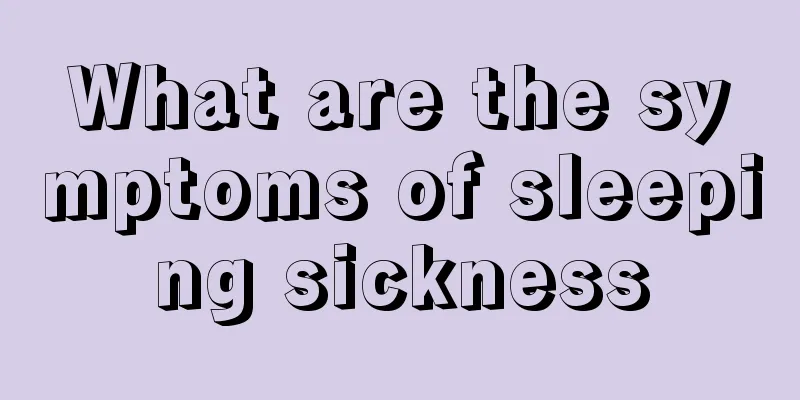What are the symptoms of sleeping sickness

|
Sleeping sickness is a common disease in daily life, also known as sleeping sickness. If it is not treated in time after the onset of the disease, it will be very harmful to the growth of the human body. Therefore, understanding the symptoms of sleeping sickness is very helpful for timely detection and treatment. So what are the symptoms of sleeping sickness? In fact, it has four symptoms, the first symptom is paroxysmal narcolepsy. 1. Narcolepsy When patients are awake, they are generally in a state of frequent and fluctuating low alertness, which is more obvious in the afternoon. As sleepiness increases, short sleep occurs. Most patients feel increased sleepiness before an attack, but only a few patients suddenly fall asleep from a relatively awake state. A monotonous environment, such as reading and listening to lectures, can easily induce it. Typical cases can occur in various activities, such as eating, speaking, operating machines, driving vehicles, etc. Each attack lasts from a few seconds to a few hours, and most last for tens of minutes. The sleep level is usually not deep and is easy to wake up. After waking up, you generally feel temporarily clear-headed. It may occur several times a day. 2. Cataplexy Cataplexy is a brief, fully reversible episode of motor inhibition characterized by a sudden loss or decrease in voluntary muscle strength. It may occur in 50% to 70% of patients. It is often triggered by laughter, anger, excitement, tension, fatigue or fullness. The typical attack is a slack jaw, head dropped forward, arms dropped to the side, and knees spread apart. Complete loss of muscle strength can lead to trauma or even fractures. However, the severity of the attacks is not always so severe. It may also simply manifest as a short-term, local or systemic feeling of weakness. The patient may experience blurred vision, interrupted speech, irregular breathing, slight bending of the knees, or sudden dropping of objects. It may be accompanied by involuntary movements, such as tremors of the head and eyelids, facial spasms, and may also be accompanied by autonomic nervous system symptoms such as palpitations and pallor. These atypical attacks are often overlooked by doctors and should be given special attention. Symptoms often disappear once the emotions return to normal or the body is touched. Cataplexy is accompanied by inhibition of tendon reflexes, but the patient remains conscious throughout. The frequency of attacks can be as soon as every few days or months, and some may have 4 to 5 attacks a day. An attack can last from a few seconds to 30 minutes. The relationship between cataplexy and other symptoms is that 50% occur at the same time, 25% occur 1 to 5 years after the onset of narcolepsy, and 15% occur 10 years after the onset of narcolepsy. It is extremely rare for cataplexy to occur before narcolepsy. 3. Sleep paralysis Sleep paralysis occurs in approximately 20% to 30% of patients with sleeping sickness, and may also occur alone. Flaccid quadriplegia occurs occasionally after waking up or while falling asleep (either during a nap or during nighttime sleep). The patient is conscious but unable to make any sound or move, and is often accompanied by anxiety and hallucinations. The symptoms usually resolve within seconds to minutes, but occasionally last for hours. An attack can often be stopped by someone touching the patient or talking to him or her, but it may recur if no action is taken. 4. Hallucinations during sleep Hallucinations during sleep onset may occur in about 30% of patients. It often occurs together with sleep paralysis. Hallucinations mainly occur during the sleep phase, and are mainly visual and auditory hallucinations, but may also be somatosensory hallucinations such as touch and pain. The content is mostly vivid and mostly reflects the daily experiences of patients. |
<<: What should I do if I have pain all over my body?
>>: What should I do if my throat is swollen and my body aches?
Recommend
What is herpes simplex virus
The herpes simplex virus is frequently spread in ...
What is the reason for the growth of meat balls on the arms? Here are some things to pay attention to
There are two main reasons for the growth of pimp...
Is it better for a soymilk machine to have internet or not?
In our daily life, we often use soymilk machines ...
What are the nursing methods after gastric cancer surgery? There are two aspects
Postoperative care for gastric cancer is generall...
What is gout and what are its symptoms
When it comes to gout, many people know about it....
The lower digestive tract includes
The human digestive system consists of two major ...
Is it good to soak your feet with the residue of used Chinese medicine?
Nowadays, foot soaking is not just something that...
What are the earliest symptoms of renal tuberculosis
Renal tuberculosis is relatively common in clinic...
Is 7mm breast cancer considered early stage?
7mm breast cancer is usually in the early stage, ...
Still in pain after transforaminal endoscopic lumbar disc surgery
It is abnormal to still have lumbar pain after in...
The difference between lipstick and lip gloss
Usually, many women will apply lipstick or lip gl...
What do women need to prepare when going to Tibet
With the rise of tourism in recent years, many gi...
What are the side effects of oxaliplatin?
Injection of oxaliplatin may cause anemia, leukop...
The early symptoms of colorectal cancer should alert the elderly
Elderly people are prone to various diseases. For...
Why is it that I can’t breathe in my throat?
Some people always feel that there is a foreign o...









